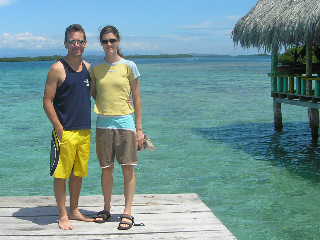 I headed to Posadas, the capital of the region of Missiones, which is about 5 hours bus ride south of Iguazu falls, as I wanted to check out the ruins of Jesuit Missions which are in the area.
I headed to Posadas, the capital of the region of Missiones, which is about 5 hours bus ride south of Iguazu falls, as I wanted to check out the ruins of Jesuit Missions which are in the area.I checked out the local museum in posadas and found a section on local cookery! There was also a very friendly guide who explained everything. So I learnt about traditional stews made from manioca/yuka, corn, beans and meat. And about the little cheese breads I´d been snacking on - also made from manioca flour. Interestingly a lot of the fruit and veg goes by different names here... fresa (strawberry) is flottilla, maracuya (passionfruit) is mburucuyu or something like that.
 A bit of history about the Jesuit missions... The Jesuits came here around 1690, and set up over 30 missions around the area for the Guarani indian in areas that are now part paraguay, part argentina and part brazil. Whats odd is that the Guarani prior to that were nomads living in tribes in the jungle, worhiping water trees and animal spirits, were apparently being harassed by spaniards and outlaws who would steal from them, and take them as slaves if it suited. So apparently the offer of a house, protection and being taught farming and trades was appealling... Anyway it worked, and missions housing around 7000 people were built and functioned with only 2 missionary priests at times! The Priests learnt and taught in local language, and the missions became known for their unique music (mixture of Guarani singing and european string instruments) and amazing craftsmanship and wood carving in particular. The missions worked for about 150 years, then the spanish crown felt threatened by their status as a almost autonomous state, and ordered thier expulsion. Although Spanish took over the missions, they didn´t treat the Guarani well or protect them, and within 30 years all had fled, buidlings looted, and left to be overrun by the jungle for 150 years.
A bit of history about the Jesuit missions... The Jesuits came here around 1690, and set up over 30 missions around the area for the Guarani indian in areas that are now part paraguay, part argentina and part brazil. Whats odd is that the Guarani prior to that were nomads living in tribes in the jungle, worhiping water trees and animal spirits, were apparently being harassed by spaniards and outlaws who would steal from them, and take them as slaves if it suited. So apparently the offer of a house, protection and being taught farming and trades was appealling... Anyway it worked, and missions housing around 7000 people were built and functioned with only 2 missionary priests at times! The Priests learnt and taught in local language, and the missions became known for their unique music (mixture of Guarani singing and european string instruments) and amazing craftsmanship and wood carving in particular. The missions worked for about 150 years, then the spanish crown felt threatened by their status as a almost autonomous state, and ordered thier expulsion. Although Spanish took over the missions, they didn´t treat the Guarani well or protect them, and within 30 years all had fled, buidlings looted, and left to be overrun by the jungle for 150 years. Anyway I went to visit San Ignacio Mini, which has been partially restored (1940s I think), and is quite impressive with large standing walls, parts of the facade of the church and bigger buidlings, and quite clearly recognisable rows of housing. Its got quite a lot of tourists, unlike the second lot of ruins I visited in Loreto which I had to myself with a personal guide! They in comparison are more mounds within the forest with occasional brickwork suggesting the church that was. They´ve just started work on excavating certain parts of interest (like the latrines which had running water) but the rest is still waiting to be discovered...
Anyway I went to visit San Ignacio Mini, which has been partially restored (1940s I think), and is quite impressive with large standing walls, parts of the facade of the church and bigger buidlings, and quite clearly recognisable rows of housing. Its got quite a lot of tourists, unlike the second lot of ruins I visited in Loreto which I had to myself with a personal guide! They in comparison are more mounds within the forest with occasional brickwork suggesting the church that was. They´ve just started work on excavating certain parts of interest (like the latrines which had running water) but the rest is still waiting to be discovered...










No comments:
Post a Comment